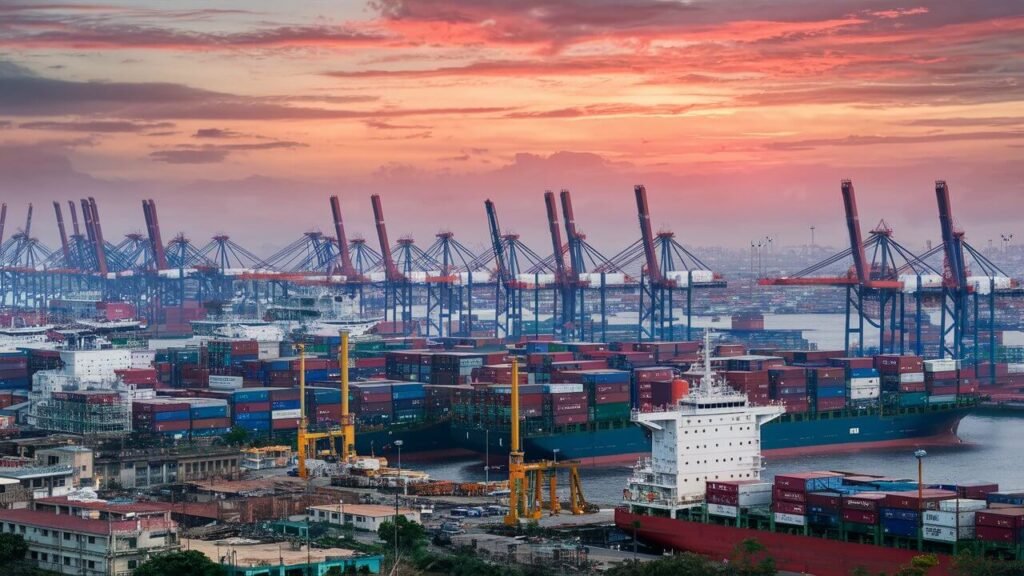India’s export sector has witnessed a significant milestone in the April to June quarter, crossing the USD 200 billion mark. This robust performance has instilled optimism within the government, with projections set towards an ambitious annual target of USD 800 billion. The impressive figures reflect India’s growing prowess in global trade and its strategic efforts to bolster export-driven economic growth.
Strong Performance in Key Sectors
The stellar export figures are attributed to strong performances across various key sectors. Engineering goods, petroleum products, and gems and jewelry have been standout contributors. Engineering goods alone accounted for a substantial portion of the total exports, reflecting the sector’s resilience and adaptability to global demand.
The petroleum products sector has also shown remarkable growth, buoyed by increasing global energy demands and strategic trade agreements. Additionally, the gems and jewelry sector, a traditional stronghold for Indian exports, has continued to shine brightly on the global stage, driven by high demand in major markets such as the United States and Europe.
Government Initiatives and Policy Support
The government’s proactive initiatives and policy support have been pivotal in achieving these impressive export figures. The Foreign Trade Policy (FTP) 2021-26, introduced earlier this year, has played a crucial role in enhancing the competitiveness of Indian exports. Key measures under the FTP include:
- Export incentives and subsidies: Providing financial support to exporters to enhance their global competitiveness.
- Ease of doing business: Streamlining regulatory processes and reducing bureaucratic hurdles for exporters.
- Infrastructure development: Investing in port infrastructure and logistics to facilitate smoother trade operations.
These measures have collectively created a conducive environment for exporters, enabling them to tap into new markets and expand their global footprint.
Diversification of Export Destinations
A significant aspect of India’s export growth has been the diversification of its export destinations. While traditional markets like the United States and Europe remain crucial, there has been a notable shift towards emerging markets in Asia, Africa, and Latin America. This diversification strategy has helped mitigate risks associated with over-reliance on specific regions and has opened up new avenues for growth.
Focus on High-Value Products
India’s export strategy has increasingly focused on high-value products, moving away from traditional low-value goods. This shift is evident in the growing export figures for sectors such as pharmaceuticals, automobiles, and information technology. The pharmaceutical sector, in particular, has seen a surge in exports, driven by India’s position as a global leader in generic drug manufacturing.
The automobile industry has also made significant strides, with increasing demand for Indian-made vehicles in international markets. Furthermore, the IT sector continues to be a major contributor, with software exports and IT-enabled services gaining traction globally.
Strategic Trade Agreements
Strategic trade agreements have been instrumental in enhancing India’s export performance. Recent agreements with countries like the United Arab Emirates, Australia, and Japan have opened up new opportunities for Indian exporters. These agreements have not only reduced tariff barriers but have also facilitated smoother trade relations, providing a competitive edge to Indian products in these markets.
Challenges and Future Outlook
Despite the remarkable growth, the export sector faces several challenges. Global economic uncertainties, fluctuating commodity prices, and geopolitical tensions pose risks to sustained export growth. Additionally, supply chain disruptions, exacerbated by the COVID-19 pandemic, continue to impact trade operations.
However, the government’s optimism is underpinned by its robust policy framework and strategic initiatives aimed at mitigating these challenges. Efforts are being made to enhance supply chain resilience, improve trade logistics, and strengthen bilateral trade relations. The focus on innovation and technology adoption is also expected to drive future growth in the export sector.
Conclusion
India’s export sector has achieved a significant milestone by crossing the USD 200 billion mark in the April to June quarter. The government’s optimism towards reaching the USD 800 billion annual target is supported by strong performances in key sectors, proactive policy measures, and strategic trade agreements. While challenges persist, the future outlook remains positive, with continuous efforts to enhance the global competitiveness of Indian exports.

